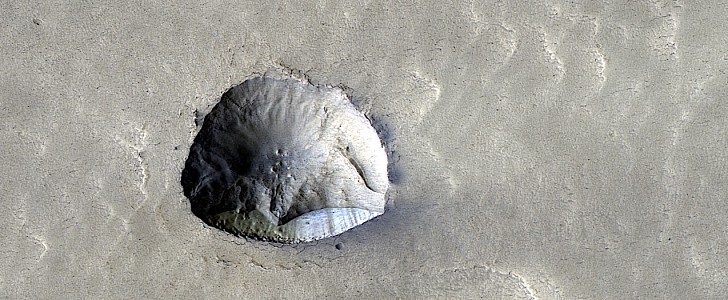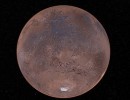Despite it sitting butt naked in front of our orbital cameras and rovers, and displaying all of its features for all to see, Mars still has tons of mysteries surrounding it. One of them would be the number of craters that effectively litter its surface.
You see, Mars is on one side of the Asteroid Belt, and that puts it in the direct path of the pieces of floating rocks heading toward the Sun. Many of them ended up landing hard on the surface of the planet, leaving it incredibly scarred, but it's impossible to estimate just how many.
Depending on a large number of factors, from the size of the asteroid, its composition, angle of impact, and even time that has passed since, Martian craters come in all sorts of shapes and sizes, and one can see all sorts of similarities with things we know of from here on Earth.
The crater we’re here to stare at today is located in an undisclosed region of the planet and is shown as the HiRISE camera has seen it back in September last year from an altitude of 300 km (186 miles).
Appearing to the naked eye as one of those chips walls tend to get from time to time, it’s much more important than that. Located somewhere mid-latitude, it appears to be filled with “smooth material” that according to scientists from NASA and the University of Arizona is “probably ice covered with a little dirt.”
The crater is a tiny one, compared to others, measuring about 250 meters (800 feet) across, but it’s important for the people studying the planet as its “north-facing cliff appears to expose icy material that’s similar to other pole-facing scarps showing buried ice elsewhere on the planet.”
Such features “give us a cut-away view of the buried ice in that location and can help answer questions about what the Martian climate was like when this ice formed.”
Depending on a large number of factors, from the size of the asteroid, its composition, angle of impact, and even time that has passed since, Martian craters come in all sorts of shapes and sizes, and one can see all sorts of similarities with things we know of from here on Earth.
The crater we’re here to stare at today is located in an undisclosed region of the planet and is shown as the HiRISE camera has seen it back in September last year from an altitude of 300 km (186 miles).
Appearing to the naked eye as one of those chips walls tend to get from time to time, it’s much more important than that. Located somewhere mid-latitude, it appears to be filled with “smooth material” that according to scientists from NASA and the University of Arizona is “probably ice covered with a little dirt.”
The crater is a tiny one, compared to others, measuring about 250 meters (800 feet) across, but it’s important for the people studying the planet as its “north-facing cliff appears to expose icy material that’s similar to other pole-facing scarps showing buried ice elsewhere on the planet.”
Such features “give us a cut-away view of the buried ice in that location and can help answer questions about what the Martian climate was like when this ice formed.”






